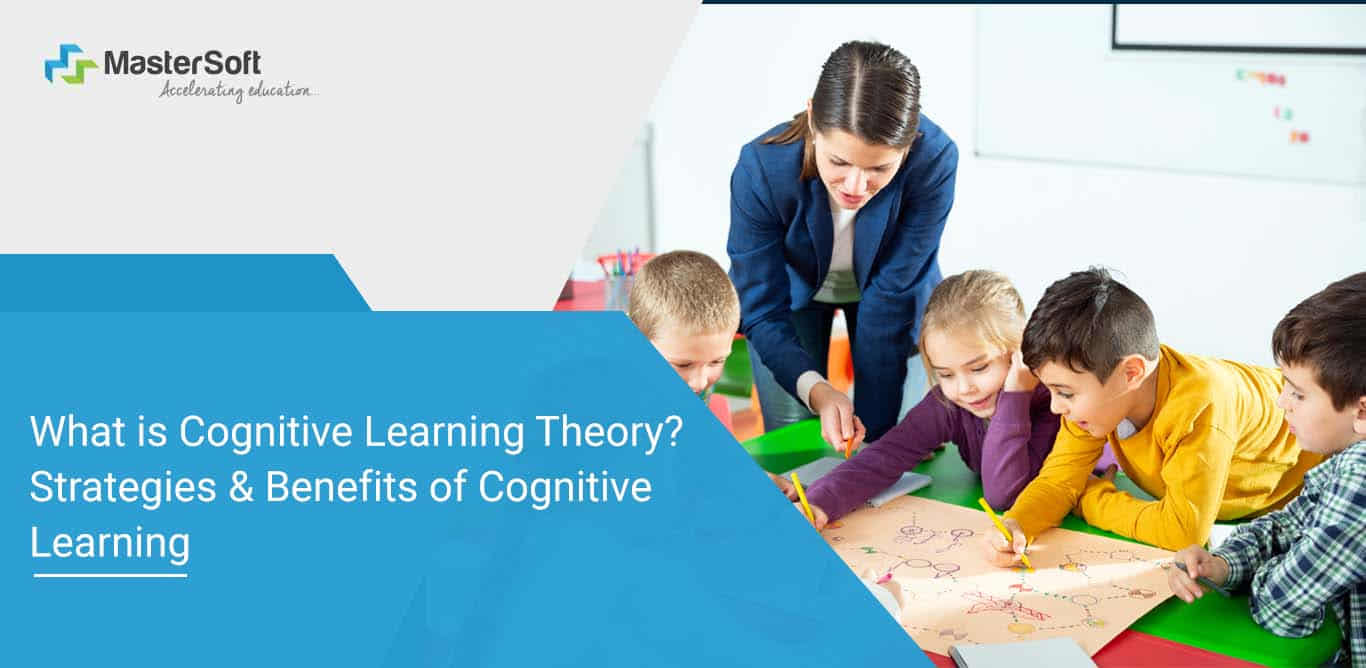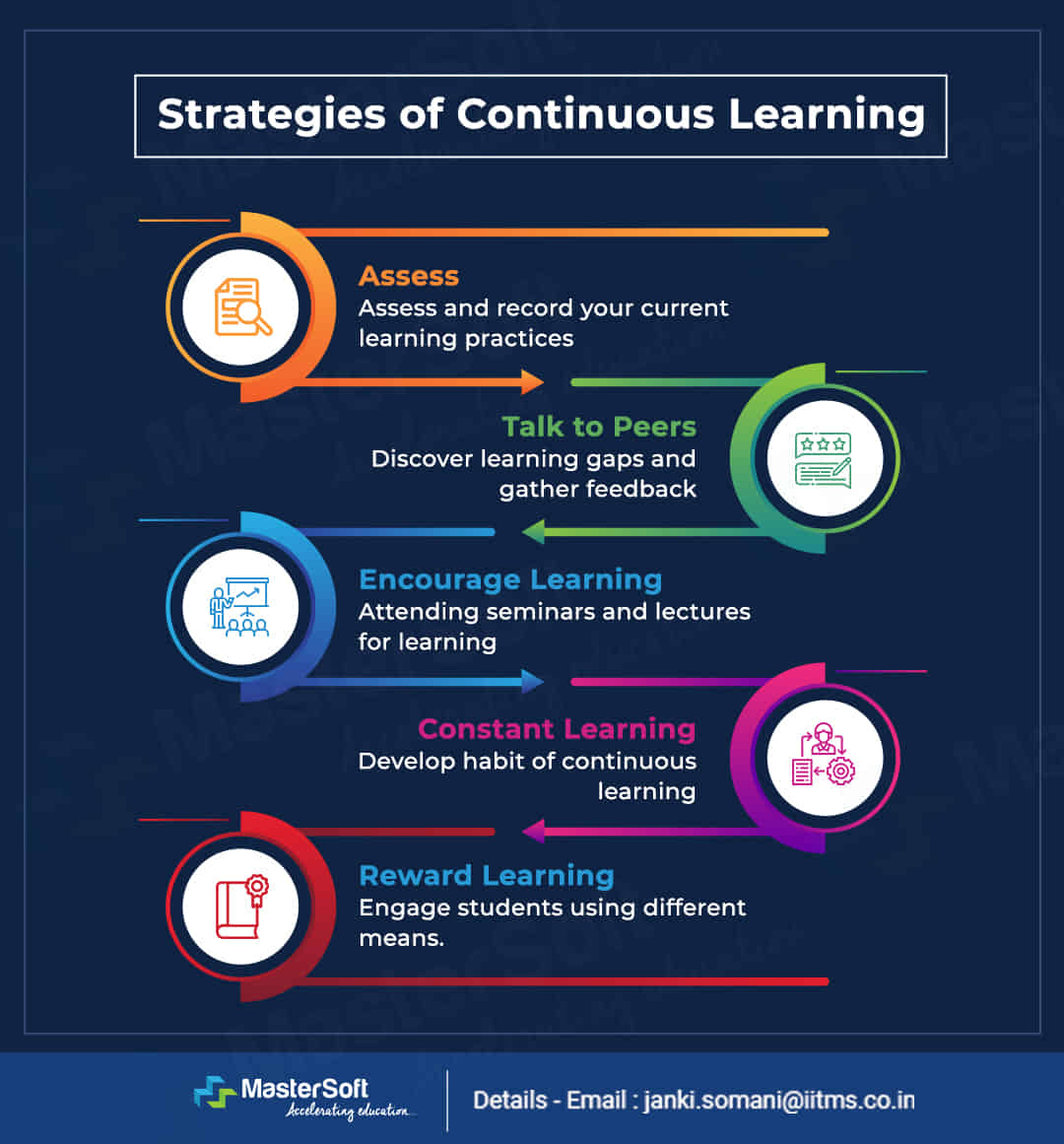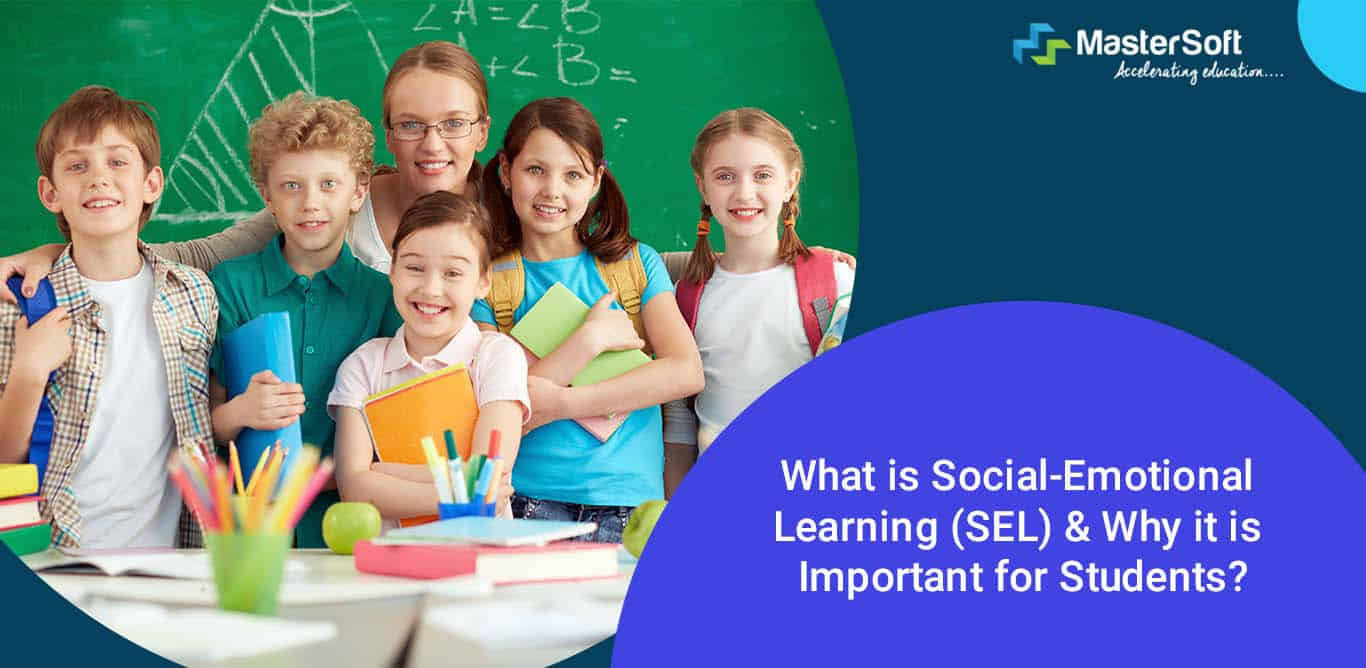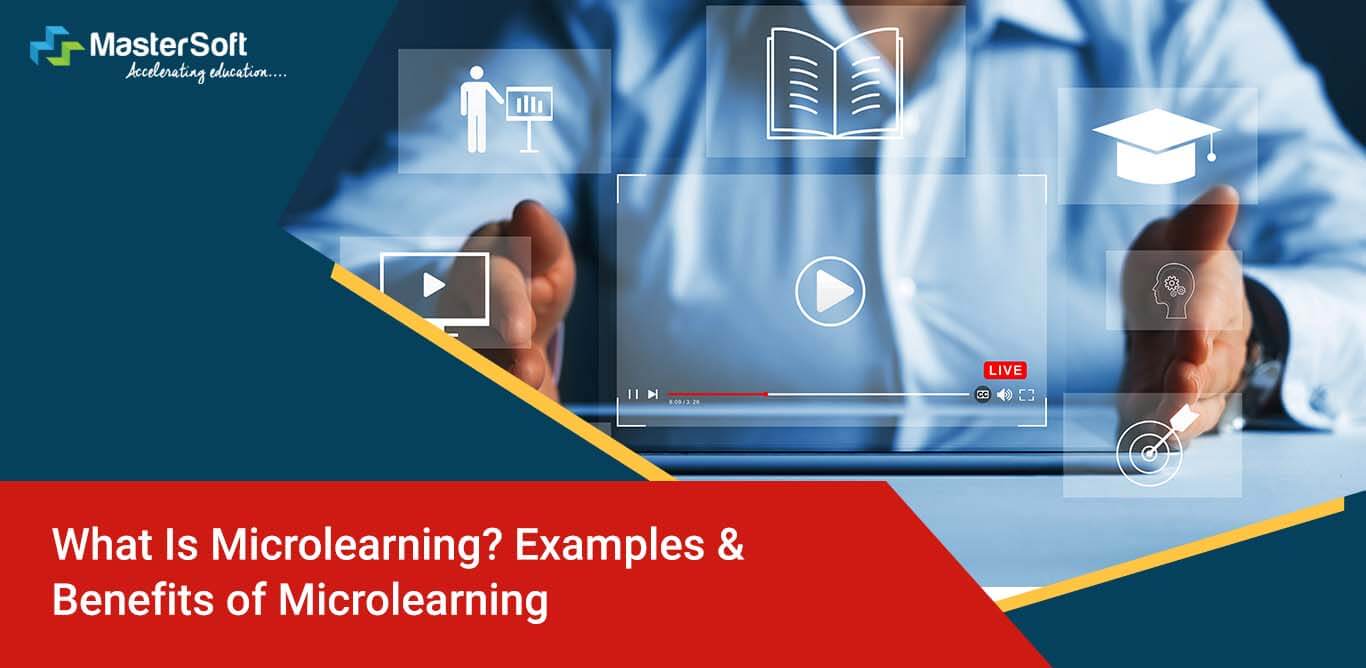
05, April 2022
"Learning is not a destination, it is a continuous process" is a quote by a renowned author and motivational speaker that relates to learning being an ongoing process. The statement proves to be a testament to the ever-changing world, wherein technology plays a significant part. Moreover, technology is developing rapidly with time and ensuring the transmission of information easily and conveniently.
Hence, in such a situation, organisations simultaneously have been preparing to facilitate training to instil necessary knowledge in the employees. Similarly, educational institutes strive for enriching the skills of the students, and continuous learning has proven to be an appropriate method to accomplish the goal.
What is Continuous Learning?
The method of acquiring new skills and knowledge continually over a period of time is called continuous learning. The process also helps people to develop both personally and professionally, resulting in getting new opportunities and achieving full potential.
The continuous learning process is an ongoing extension of knowledge and skillsets that are often utilised in the context of professional development. But it can also be used in the educational space, where teachers employ several strategies to implement the learning. They often include activities such as debates and group discussions that enable them to learn in an interactive manner.
It includes dynamic, relevant, engaging and readily accessible learning, it also encourages learners to focus on their strengths and their ability to apply their knowledge. Therefore, an appropriate delivery format is crucial for an engaging and effective learning experience. Also, a combination of learning interventions and interactions are crucial factors that contribute to thought leadership and foster innovation.
Continuous learning has become much more flexible despite physical restrictions due to:
- The availability of hybrid learning wherein, both virtual and in-person classroom learning/teaching facilitates self-paced learning.
- Technology plays a significant part in creating dynamic classrooms and allows teachers to use several methodologies that help to achieve learning outcomes.
- Consequently, it has helped to reduce the gap between learning and the application of knowledge in real life.
Important Aspects of Continuous Learning
An integral part of continuous learning is the content that the instructors need to use strategically. Also, in the process, the instructors become facilitators by creating an active dialogue with participants thereby building engaging and collaborative experiences. A few strategies that they can use are as follows:
Learner’s needs
- Immediate - The things that students need to know and understand today itself.
- Intermediate - The skill sets that they require to learn and grow
- Transitional - The things that they need to learn to satisfy their long-term organisational goals, to prepare for their desired career.
What Is Cognitive Learning Theory? Strategies & Benefits Of Cognitive Theory?

Strategies of Continuous Learning

1. Workshops/ Seminars
The institute can organise seminars or workshops related to different skills such as deductive reasoning, critical thinking, data science, business analysis etc. These workshops are instrumental in introducing students to skills that are significant for employment opportunities.
2. Conferences
As a part of hosting scholastic and co-scholastic events in the school/ college, the institute can conduct educational conferences. As it will give them the opportunity to increase their networking skills, meet with leaders in their fields, improve their communication and presentation abilities, and learn about the latest research in their area.
Similarly, it will also teachers to better demonstrate their professionalism, their understanding of the ongoing need for professional learning and the broader role of educators. Conference attendance can also support teachers to better meet the needs of their students
3. Training Programs
Higher educational institutes can also facilitate training programs that deal with providing training in special courses and programs. These courses should be relevant to the industry demands so that they contribute to the student's preparation for the future.
4. Online Learning Courses
With every passing year, there are new technological innovations and discoveries, hence there is an emergence of new topics. Hence, institutes can also facilitate continuous learning through online learning courses.
How Does Continuous Learning Take Place?
Continuous learning takes place broadly in two ways: Social learning and Self-directed learning
1. Social Learning
People learn through interacting or communicating and observing others; this can happen formally or informally. This type of learning can also occur in person or via a virtual medium. Examples of social learning are as follows:
Collaborative Learning
Collaborative learning is an approach wherein students work together to solve a problem by mutually searching for understanding, solutions, or meanings and creating a product. Collaborative learning activities vary widely, but most of them focus on students’ exploration or application of the course material, not simply the teacher’s presentation or explication of it.
Instead of beginning with facts and ideas followed by their applications, students frequently begin with problems. This learning style produces an intellectual synergy of many minds that work together in collaboration to achieve a common aim. On the other hand, the instructor witnesses diverse perspectives, experiences and aspirations, which they take into account during the continuous and comprehensive evaluation of particular students.
Discussion and Debates
During discussions or debates, students get the opportunity to express their opinions and engage in a healthy exchange of views. As a result, they experience diverse perspectives and realizes the importance of hearing out others and voicing their own thoughts coherently.
2. Self-directed Learning
Learning needs to go beyond the four walls of the classroom, which the institutes and instructors increasingly have been adopting. Besides, teachers have been making it a part of the pedagogy, wherein they provide students with the opportunities to pose critical questions related to content. In fact, self-directed learning is appropriate for implementing Bloom's Taxonomy's "analyze" aspect, wherein students can explore their doubts and uncertainties and come up with various questions.
Apart from teachers providing appropriate help in terms of answering their questions, they can also give clues, which are helpful in self-directed learning.
What Is Social Emotional Learning (SEL) And Why It Is Important For Students?

Benefits of Continuous Learning
1. Boosts Confidence
A student becomes self-confident after gaining additional knowledge and has various career options after upskilling himself. Therefore, he/she does not shy away from any challenges, rather they are self-aware of the surroundings, hence is ready to take up any task.
2. Changes Perspective
With further learning, students get to see varied dimensions of any particular object, person or event, hence, continuous learning provides better understanding. Their views and attitudes evolve and they develop individualised thinking and are capable of making informed decisions.
3. Career Development
Instructors follow the syllabus or curriculum recommended by the National Curriculum Framework, which also includes strategies and activities. Furthermore, throughout the year, students participate in several assessments that help the teacher determine their strengths and weaknesses.
Similarly, teaching them new skills helps to inculcate them with the knowledge which is essential for landing any high-demand jobs.
4. Boosts Productivity
When they feel fulfilled and confident, it automatically propels them to work and learn productively. Hence, it further serves to increase their confidence in themselves and encourages them to learn more.
5. Increases Curiosity
When students are following a continuous learning approach it can be linked to lifelong learning, relating to the fact that knowledge gaining is an uninterrupted process. Hence, learning leads to increasing their curiosity about seeking more information about the real world. Also, it is crucial to remember that knowledge retention is key to the application in an appropriate situation.
How To Implement Continuous Learning?
The Institute and instructors must work together to promote the importance of continuous learning. They have to propound the fact that learning does not finish after the class gets over, on the contrary, it is a continuous process. Therefore, they should collaborate to conduct various activities and programs as mentioned above, which would propel them to do independent research and prepare further.
At the same time, it is essential for the institute to administer proper student support and resources to help students. Especially, when conducting strategies like project-based learning, instructors must act accordingly and provide appropriate resources.
Streamline Teaching-Learning Process with MasterSoft’s Learning Management System.
Mobile: 08448010216
Email:info@mastersofterp.com
Recent
- NEP 2020 & College Autonomy: Complete Guide
- ICT For Higher Education - Smart Move Towards Online Teaching And Learning
- Online Examination Software For Post-Exam Analysis, Better Learning Outcomes & Decision Making
- The Best School Management System To Enhance Students Learning Experience
- Complete Guide To Learning Outcome Based Curriculum Framework (LOCF) - Part 1
- How To Manage Exam Schemes, Rules & Result Processing Online
- How To Manage College Applications, Merit List Generation & Online Admissions
- Complete Guide To The National Board Of Accreditation (NBA Accreditation)
- The Ultimate Checklist To Safeguard Your University’s Data
- Top 3 Reasons Why Higher Education Institutions Should Focus On Achieving Autonomy
- The Beginner’s Guide To Outcome Based Education Process (Part 2)
- Tips to Gear up Your Children To Return Back to School after Lockdown
- National Education Policy: All You Need to Know about NEP 2020 for Schools – Part 1
- Why Educators Need to Put Maslow Before Bloom
- Five Things You Should Know About Remote Learning as an Educator
- What is e-learning?
- Top Advantages of Online Assessment Tools
- What Is The NBA And Why Does It Matter?
- How Can Colleges Be Prepared for NAAC Peer Team Visit?
- ICT for Higher Education - Smart Move towards Online Teaching and Learning
- How to implement Choice Based Credit System?
- Why Online Fee Collection Software is a Must for Educational Institutions





